Public Health Leadership Framework: Case Study and Analysis Report
VerifiedAdded on 2023/01/19
|9
|2429
|87
Report
AI Summary
This report analyzes a case study involving Helen, a general practitioner nominated as a public health officer in Warnambool, Victoria. The report critically examines the Australian Health Leadership Framework, highlighting key areas Helen must focus on to contribute positively to the community's development, considering factors like sanitation, housing, infection control, and the needs of an aging and culturally diverse population. The paper also includes a self-assessment using a leadership assessment tool, identifying strengths and weaknesses in leadership skills. The report recommends distributive leadership and emphasizes the importance of effective communication, vision-setting, and proactive decision-making to improve healthcare outcomes and address community challenges. Additionally, the report reflects on the student's personal leadership skills and outlines a course of action if they were in Helen's position, including participation in leadership workshops and review of NHS documents to enhance leadership capabilities.
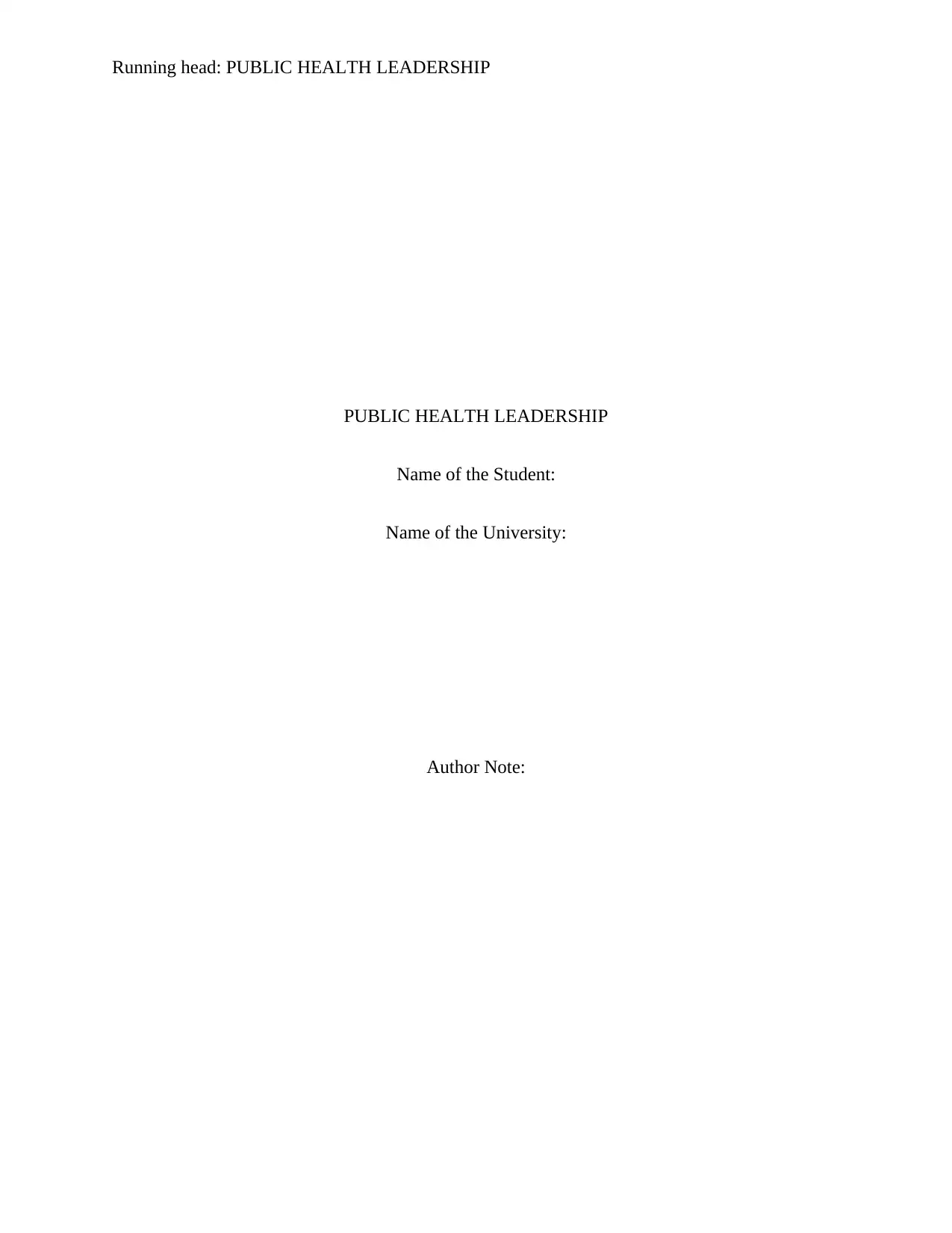
Running head: PUBLIC HEALTH LEADERSHIP
PUBLIC HEALTH LEADERSHIP
Name of the Student:
Name of the University:
Author Note:
PUBLIC HEALTH LEADERSHIP
Name of the Student:
Name of the University:
Author Note:
Paraphrase This Document
Need a fresh take? Get an instant paraphrase of this document with our AI Paraphraser
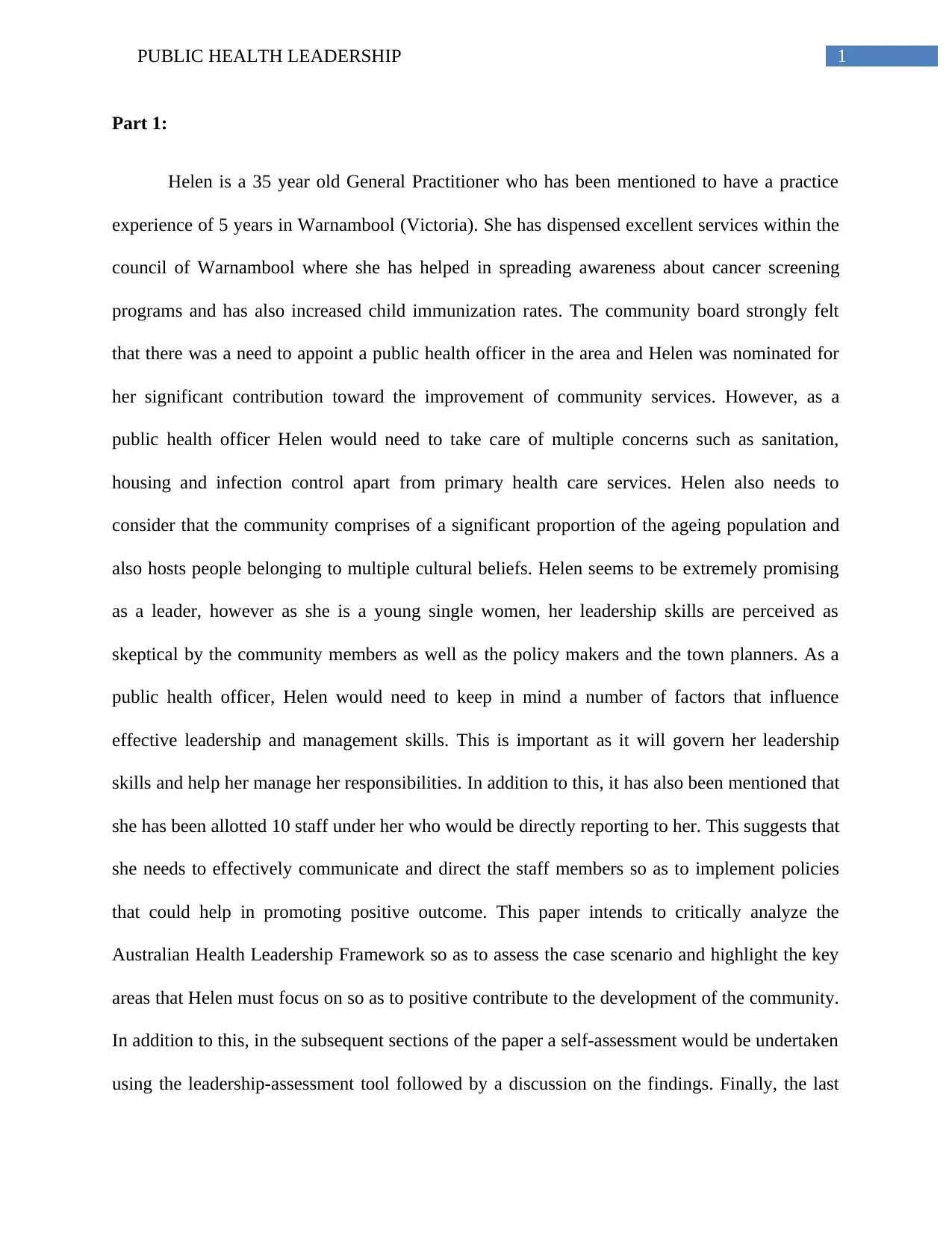
1PUBLIC HEALTH LEADERSHIP
Part 1:
Helen is a 35 year old General Practitioner who has been mentioned to have a practice
experience of 5 years in Warnambool (Victoria). She has dispensed excellent services within the
council of Warnambool where she has helped in spreading awareness about cancer screening
programs and has also increased child immunization rates. The community board strongly felt
that there was a need to appoint a public health officer in the area and Helen was nominated for
her significant contribution toward the improvement of community services. However, as a
public health officer Helen would need to take care of multiple concerns such as sanitation,
housing and infection control apart from primary health care services. Helen also needs to
consider that the community comprises of a significant proportion of the ageing population and
also hosts people belonging to multiple cultural beliefs. Helen seems to be extremely promising
as a leader, however as she is a young single women, her leadership skills are perceived as
skeptical by the community members as well as the policy makers and the town planners. As a
public health officer, Helen would need to keep in mind a number of factors that influence
effective leadership and management skills. This is important as it will govern her leadership
skills and help her manage her responsibilities. In addition to this, it has also been mentioned that
she has been allotted 10 staff under her who would be directly reporting to her. This suggests that
she needs to effectively communicate and direct the staff members so as to implement policies
that could help in promoting positive outcome. This paper intends to critically analyze the
Australian Health Leadership Framework so as to assess the case scenario and highlight the key
areas that Helen must focus on so as to positive contribute to the development of the community.
In addition to this, in the subsequent sections of the paper a self-assessment would be undertaken
using the leadership-assessment tool followed by a discussion on the findings. Finally, the last
Part 1:
Helen is a 35 year old General Practitioner who has been mentioned to have a practice
experience of 5 years in Warnambool (Victoria). She has dispensed excellent services within the
council of Warnambool where she has helped in spreading awareness about cancer screening
programs and has also increased child immunization rates. The community board strongly felt
that there was a need to appoint a public health officer in the area and Helen was nominated for
her significant contribution toward the improvement of community services. However, as a
public health officer Helen would need to take care of multiple concerns such as sanitation,
housing and infection control apart from primary health care services. Helen also needs to
consider that the community comprises of a significant proportion of the ageing population and
also hosts people belonging to multiple cultural beliefs. Helen seems to be extremely promising
as a leader, however as she is a young single women, her leadership skills are perceived as
skeptical by the community members as well as the policy makers and the town planners. As a
public health officer, Helen would need to keep in mind a number of factors that influence
effective leadership and management skills. This is important as it will govern her leadership
skills and help her manage her responsibilities. In addition to this, it has also been mentioned that
she has been allotted 10 staff under her who would be directly reporting to her. This suggests that
she needs to effectively communicate and direct the staff members so as to implement policies
that could help in promoting positive outcome. This paper intends to critically analyze the
Australian Health Leadership Framework so as to assess the case scenario and highlight the key
areas that Helen must focus on so as to positive contribute to the development of the community.
In addition to this, in the subsequent sections of the paper a self-assessment would be undertaken
using the leadership-assessment tool followed by a discussion on the findings. Finally, the last
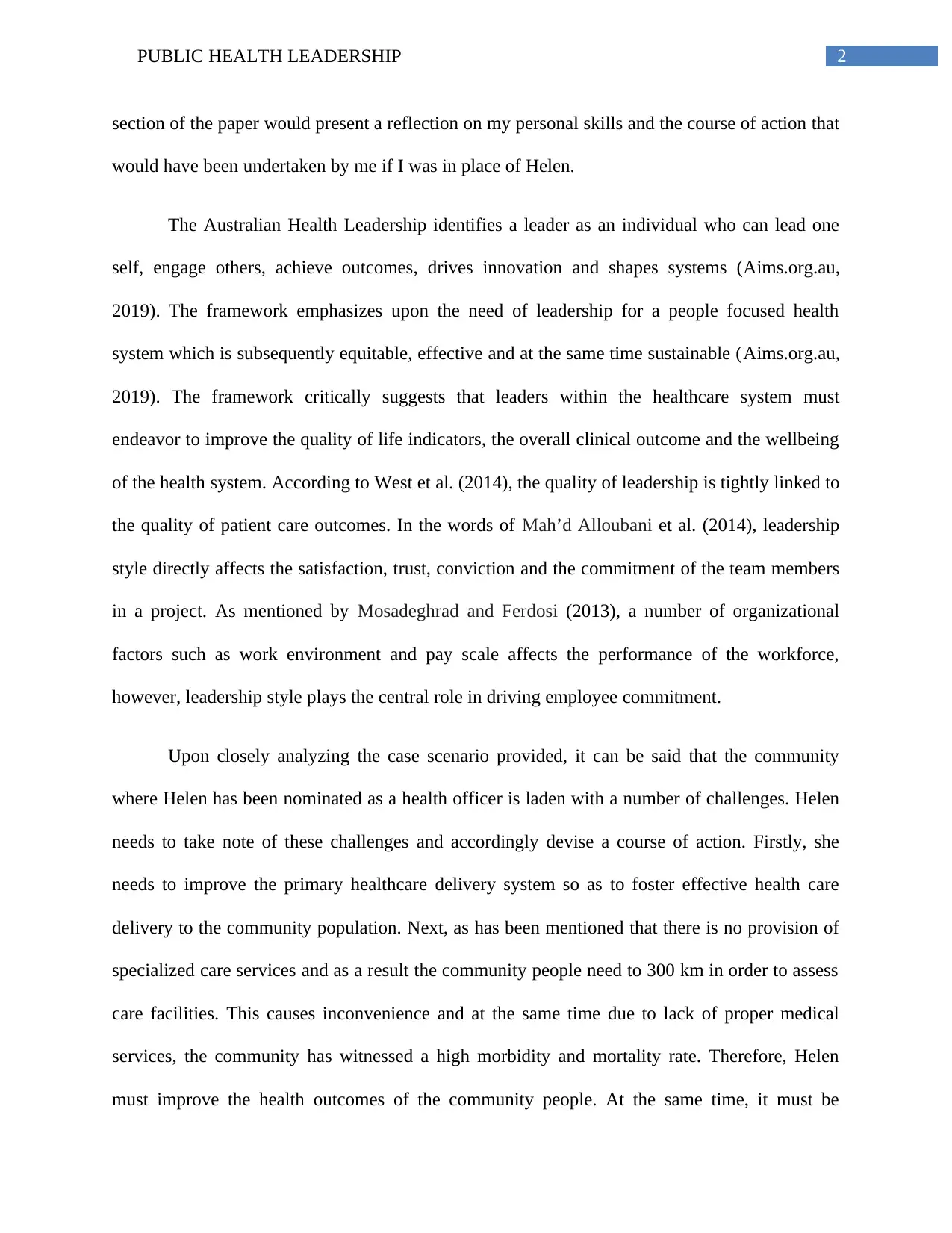
2PUBLIC HEALTH LEADERSHIP
section of the paper would present a reflection on my personal skills and the course of action that
would have been undertaken by me if I was in place of Helen.
The Australian Health Leadership identifies a leader as an individual who can lead one
self, engage others, achieve outcomes, drives innovation and shapes systems (Aims.org.au,
2019). The framework emphasizes upon the need of leadership for a people focused health
system which is subsequently equitable, effective and at the same time sustainable (Aims.org.au,
2019). The framework critically suggests that leaders within the healthcare system must
endeavor to improve the quality of life indicators, the overall clinical outcome and the wellbeing
of the health system. According to West et al. (2014), the quality of leadership is tightly linked to
the quality of patient care outcomes. In the words of Mah’d Alloubani et al. (2014), leadership
style directly affects the satisfaction, trust, conviction and the commitment of the team members
in a project. As mentioned by Mosadeghrad and Ferdosi (2013), a number of organizational
factors such as work environment and pay scale affects the performance of the workforce,
however, leadership style plays the central role in driving employee commitment.
Upon closely analyzing the case scenario provided, it can be said that the community
where Helen has been nominated as a health officer is laden with a number of challenges. Helen
needs to take note of these challenges and accordingly devise a course of action. Firstly, she
needs to improve the primary healthcare delivery system so as to foster effective health care
delivery to the community population. Next, as has been mentioned that there is no provision of
specialized care services and as a result the community people need to 300 km in order to assess
care facilities. This causes inconvenience and at the same time due to lack of proper medical
services, the community has witnessed a high morbidity and mortality rate. Therefore, Helen
must improve the health outcomes of the community people. At the same time, it must be
section of the paper would present a reflection on my personal skills and the course of action that
would have been undertaken by me if I was in place of Helen.
The Australian Health Leadership identifies a leader as an individual who can lead one
self, engage others, achieve outcomes, drives innovation and shapes systems (Aims.org.au,
2019). The framework emphasizes upon the need of leadership for a people focused health
system which is subsequently equitable, effective and at the same time sustainable (Aims.org.au,
2019). The framework critically suggests that leaders within the healthcare system must
endeavor to improve the quality of life indicators, the overall clinical outcome and the wellbeing
of the health system. According to West et al. (2014), the quality of leadership is tightly linked to
the quality of patient care outcomes. In the words of Mah’d Alloubani et al. (2014), leadership
style directly affects the satisfaction, trust, conviction and the commitment of the team members
in a project. As mentioned by Mosadeghrad and Ferdosi (2013), a number of organizational
factors such as work environment and pay scale affects the performance of the workforce,
however, leadership style plays the central role in driving employee commitment.
Upon closely analyzing the case scenario provided, it can be said that the community
where Helen has been nominated as a health officer is laden with a number of challenges. Helen
needs to take note of these challenges and accordingly devise a course of action. Firstly, she
needs to improve the primary healthcare delivery system so as to foster effective health care
delivery to the community population. Next, as has been mentioned that there is no provision of
specialized care services and as a result the community people need to 300 km in order to assess
care facilities. This causes inconvenience and at the same time due to lack of proper medical
services, the community has witnessed a high morbidity and mortality rate. Therefore, Helen
must improve the health outcomes of the community people. At the same time, it must be
⊘ This is a preview!⊘
Do you want full access?
Subscribe today to unlock all pages.

Trusted by 1+ million students worldwide
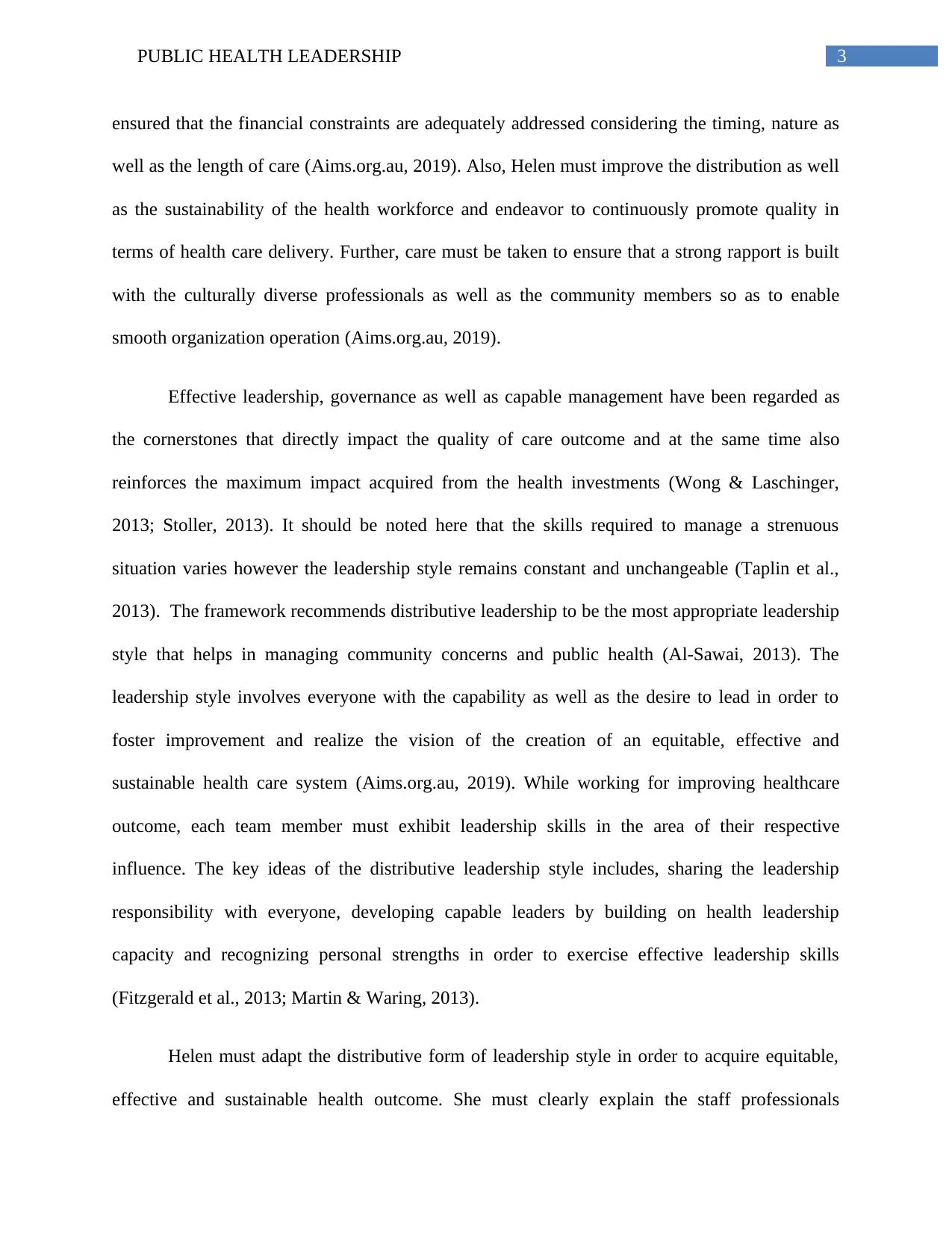
3PUBLIC HEALTH LEADERSHIP
ensured that the financial constraints are adequately addressed considering the timing, nature as
well as the length of care (Aims.org.au, 2019). Also, Helen must improve the distribution as well
as the sustainability of the health workforce and endeavor to continuously promote quality in
terms of health care delivery. Further, care must be taken to ensure that a strong rapport is built
with the culturally diverse professionals as well as the community members so as to enable
smooth organization operation (Aims.org.au, 2019).
Effective leadership, governance as well as capable management have been regarded as
the cornerstones that directly impact the quality of care outcome and at the same time also
reinforces the maximum impact acquired from the health investments (Wong & Laschinger,
2013; Stoller, 2013). It should be noted here that the skills required to manage a strenuous
situation varies however the leadership style remains constant and unchangeable (Taplin et al.,
2013). The framework recommends distributive leadership to be the most appropriate leadership
style that helps in managing community concerns and public health (Al-Sawai, 2013). The
leadership style involves everyone with the capability as well as the desire to lead in order to
foster improvement and realize the vision of the creation of an equitable, effective and
sustainable health care system (Aims.org.au, 2019). While working for improving healthcare
outcome, each team member must exhibit leadership skills in the area of their respective
influence. The key ideas of the distributive leadership style includes, sharing the leadership
responsibility with everyone, developing capable leaders by building on health leadership
capacity and recognizing personal strengths in order to exercise effective leadership skills
(Fitzgerald et al., 2013; Martin & Waring, 2013).
Helen must adapt the distributive form of leadership style in order to acquire equitable,
effective and sustainable health outcome. She must clearly explain the staff professionals
ensured that the financial constraints are adequately addressed considering the timing, nature as
well as the length of care (Aims.org.au, 2019). Also, Helen must improve the distribution as well
as the sustainability of the health workforce and endeavor to continuously promote quality in
terms of health care delivery. Further, care must be taken to ensure that a strong rapport is built
with the culturally diverse professionals as well as the community members so as to enable
smooth organization operation (Aims.org.au, 2019).
Effective leadership, governance as well as capable management have been regarded as
the cornerstones that directly impact the quality of care outcome and at the same time also
reinforces the maximum impact acquired from the health investments (Wong & Laschinger,
2013; Stoller, 2013). It should be noted here that the skills required to manage a strenuous
situation varies however the leadership style remains constant and unchangeable (Taplin et al.,
2013). The framework recommends distributive leadership to be the most appropriate leadership
style that helps in managing community concerns and public health (Al-Sawai, 2013). The
leadership style involves everyone with the capability as well as the desire to lead in order to
foster improvement and realize the vision of the creation of an equitable, effective and
sustainable health care system (Aims.org.au, 2019). While working for improving healthcare
outcome, each team member must exhibit leadership skills in the area of their respective
influence. The key ideas of the distributive leadership style includes, sharing the leadership
responsibility with everyone, developing capable leaders by building on health leadership
capacity and recognizing personal strengths in order to exercise effective leadership skills
(Fitzgerald et al., 2013; Martin & Waring, 2013).
Helen must adapt the distributive form of leadership style in order to acquire equitable,
effective and sustainable health outcome. She must clearly explain the staff professionals
Paraphrase This Document
Need a fresh take? Get an instant paraphrase of this document with our AI Paraphraser
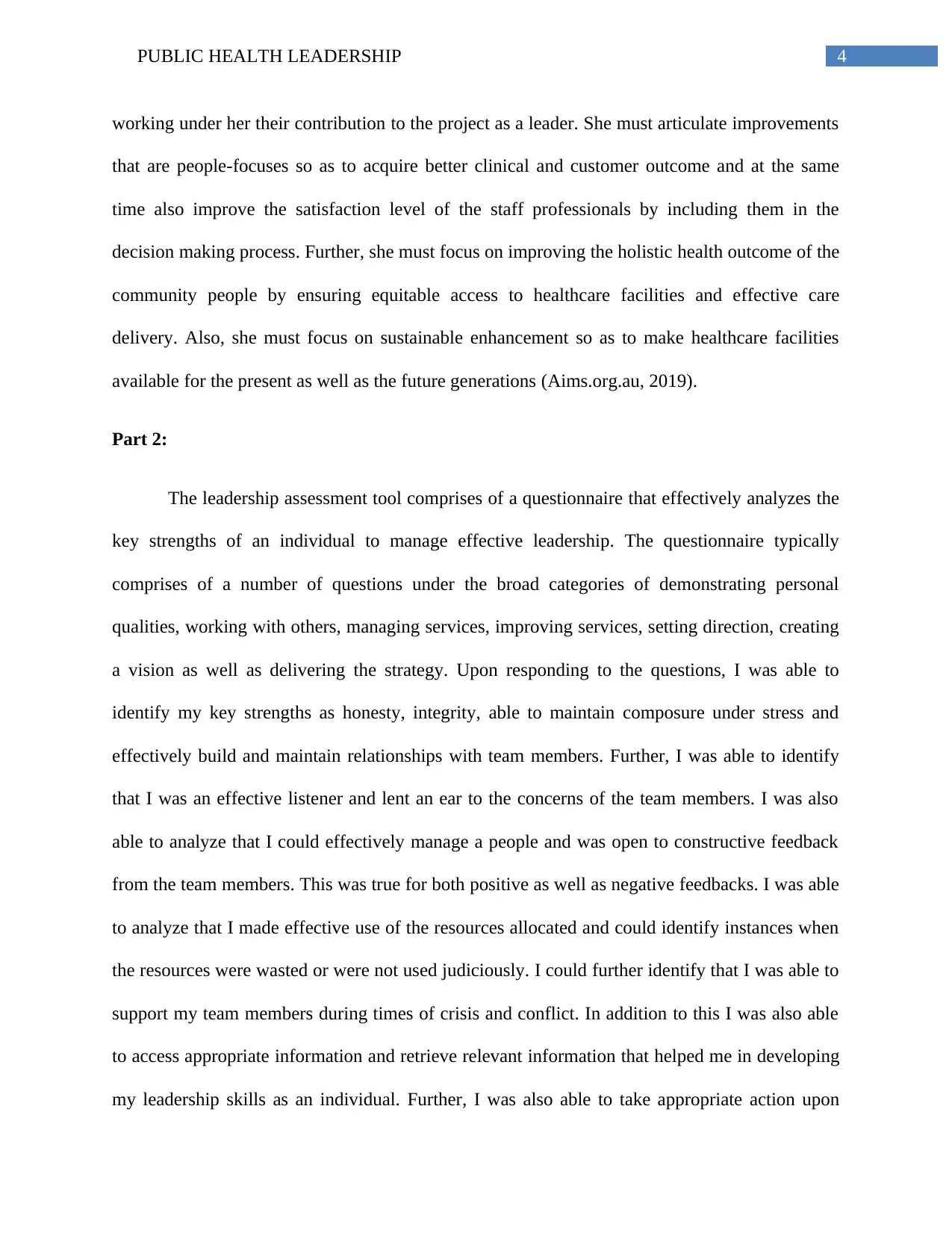
4PUBLIC HEALTH LEADERSHIP
working under her their contribution to the project as a leader. She must articulate improvements
that are people-focuses so as to acquire better clinical and customer outcome and at the same
time also improve the satisfaction level of the staff professionals by including them in the
decision making process. Further, she must focus on improving the holistic health outcome of the
community people by ensuring equitable access to healthcare facilities and effective care
delivery. Also, she must focus on sustainable enhancement so as to make healthcare facilities
available for the present as well as the future generations (Aims.org.au, 2019).
Part 2:
The leadership assessment tool comprises of a questionnaire that effectively analyzes the
key strengths of an individual to manage effective leadership. The questionnaire typically
comprises of a number of questions under the broad categories of demonstrating personal
qualities, working with others, managing services, improving services, setting direction, creating
a vision as well as delivering the strategy. Upon responding to the questions, I was able to
identify my key strengths as honesty, integrity, able to maintain composure under stress and
effectively build and maintain relationships with team members. Further, I was able to identify
that I was an effective listener and lent an ear to the concerns of the team members. I was also
able to analyze that I could effectively manage a people and was open to constructive feedback
from the team members. This was true for both positive as well as negative feedbacks. I was able
to analyze that I made effective use of the resources allocated and could identify instances when
the resources were wasted or were not used judiciously. I could further identify that I was able to
support my team members during times of crisis and conflict. In addition to this I was also able
to access appropriate information and retrieve relevant information that helped me in developing
my leadership skills as an individual. Further, I was also able to take appropriate action upon
working under her their contribution to the project as a leader. She must articulate improvements
that are people-focuses so as to acquire better clinical and customer outcome and at the same
time also improve the satisfaction level of the staff professionals by including them in the
decision making process. Further, she must focus on improving the holistic health outcome of the
community people by ensuring equitable access to healthcare facilities and effective care
delivery. Also, she must focus on sustainable enhancement so as to make healthcare facilities
available for the present as well as the future generations (Aims.org.au, 2019).
Part 2:
The leadership assessment tool comprises of a questionnaire that effectively analyzes the
key strengths of an individual to manage effective leadership. The questionnaire typically
comprises of a number of questions under the broad categories of demonstrating personal
qualities, working with others, managing services, improving services, setting direction, creating
a vision as well as delivering the strategy. Upon responding to the questions, I was able to
identify my key strengths as honesty, integrity, able to maintain composure under stress and
effectively build and maintain relationships with team members. Further, I was able to identify
that I was an effective listener and lent an ear to the concerns of the team members. I was also
able to analyze that I could effectively manage a people and was open to constructive feedback
from the team members. This was true for both positive as well as negative feedbacks. I was able
to analyze that I made effective use of the resources allocated and could identify instances when
the resources were wasted or were not used judiciously. I could further identify that I was able to
support my team members during times of crisis and conflict. In addition to this I was also able
to access appropriate information and retrieve relevant information that helped me in developing
my leadership skills as an individual. Further, I was also able to take appropriate action upon
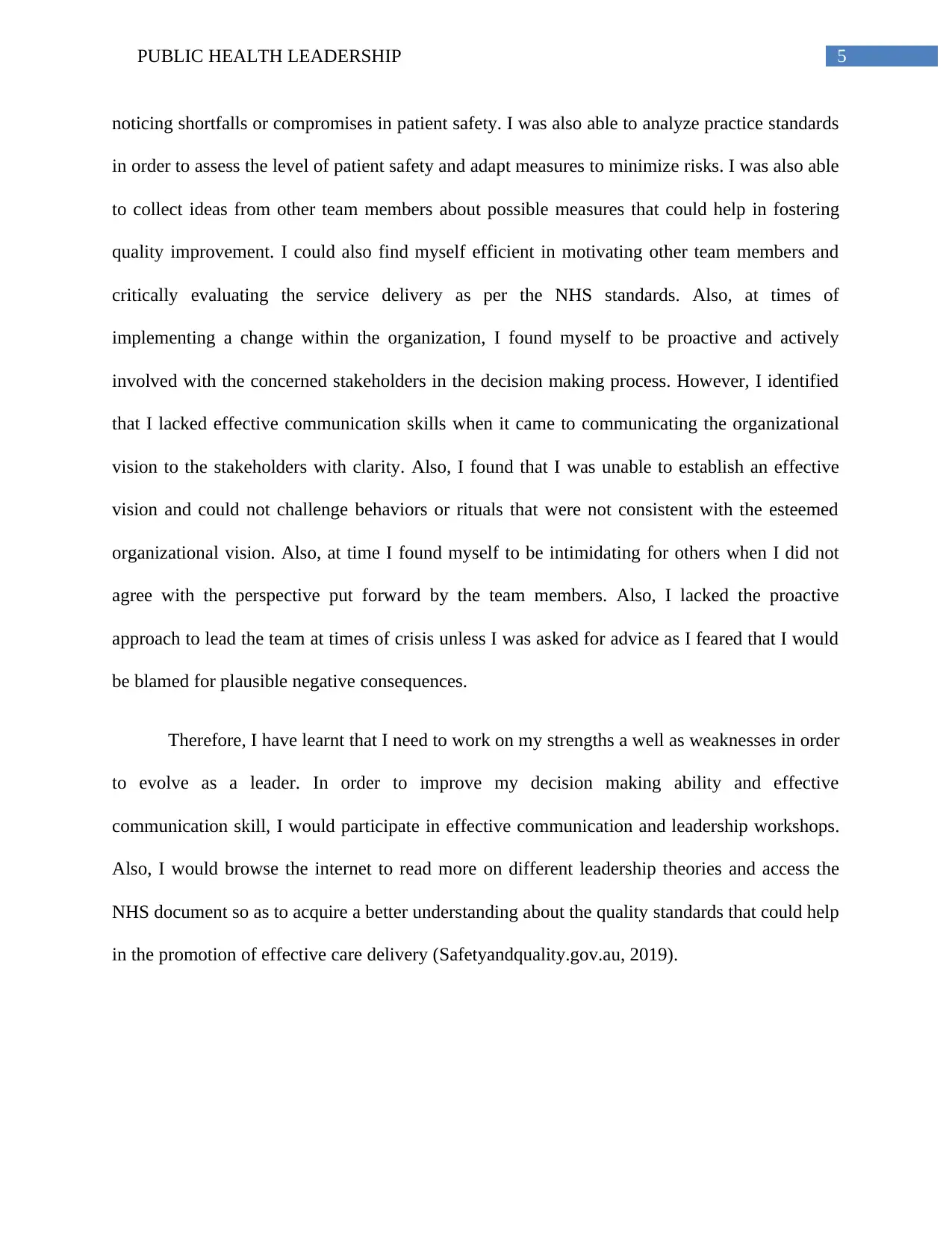
5PUBLIC HEALTH LEADERSHIP
noticing shortfalls or compromises in patient safety. I was also able to analyze practice standards
in order to assess the level of patient safety and adapt measures to minimize risks. I was also able
to collect ideas from other team members about possible measures that could help in fostering
quality improvement. I could also find myself efficient in motivating other team members and
critically evaluating the service delivery as per the NHS standards. Also, at times of
implementing a change within the organization, I found myself to be proactive and actively
involved with the concerned stakeholders in the decision making process. However, I identified
that I lacked effective communication skills when it came to communicating the organizational
vision to the stakeholders with clarity. Also, I found that I was unable to establish an effective
vision and could not challenge behaviors or rituals that were not consistent with the esteemed
organizational vision. Also, at time I found myself to be intimidating for others when I did not
agree with the perspective put forward by the team members. Also, I lacked the proactive
approach to lead the team at times of crisis unless I was asked for advice as I feared that I would
be blamed for plausible negative consequences.
Therefore, I have learnt that I need to work on my strengths a well as weaknesses in order
to evolve as a leader. In order to improve my decision making ability and effective
communication skill, I would participate in effective communication and leadership workshops.
Also, I would browse the internet to read more on different leadership theories and access the
NHS document so as to acquire a better understanding about the quality standards that could help
in the promotion of effective care delivery (Safetyandquality.gov.au, 2019).
noticing shortfalls or compromises in patient safety. I was also able to analyze practice standards
in order to assess the level of patient safety and adapt measures to minimize risks. I was also able
to collect ideas from other team members about possible measures that could help in fostering
quality improvement. I could also find myself efficient in motivating other team members and
critically evaluating the service delivery as per the NHS standards. Also, at times of
implementing a change within the organization, I found myself to be proactive and actively
involved with the concerned stakeholders in the decision making process. However, I identified
that I lacked effective communication skills when it came to communicating the organizational
vision to the stakeholders with clarity. Also, I found that I was unable to establish an effective
vision and could not challenge behaviors or rituals that were not consistent with the esteemed
organizational vision. Also, at time I found myself to be intimidating for others when I did not
agree with the perspective put forward by the team members. Also, I lacked the proactive
approach to lead the team at times of crisis unless I was asked for advice as I feared that I would
be blamed for plausible negative consequences.
Therefore, I have learnt that I need to work on my strengths a well as weaknesses in order
to evolve as a leader. In order to improve my decision making ability and effective
communication skill, I would participate in effective communication and leadership workshops.
Also, I would browse the internet to read more on different leadership theories and access the
NHS document so as to acquire a better understanding about the quality standards that could help
in the promotion of effective care delivery (Safetyandquality.gov.au, 2019).
⊘ This is a preview!⊘
Do you want full access?
Subscribe today to unlock all pages.

Trusted by 1+ million students worldwide
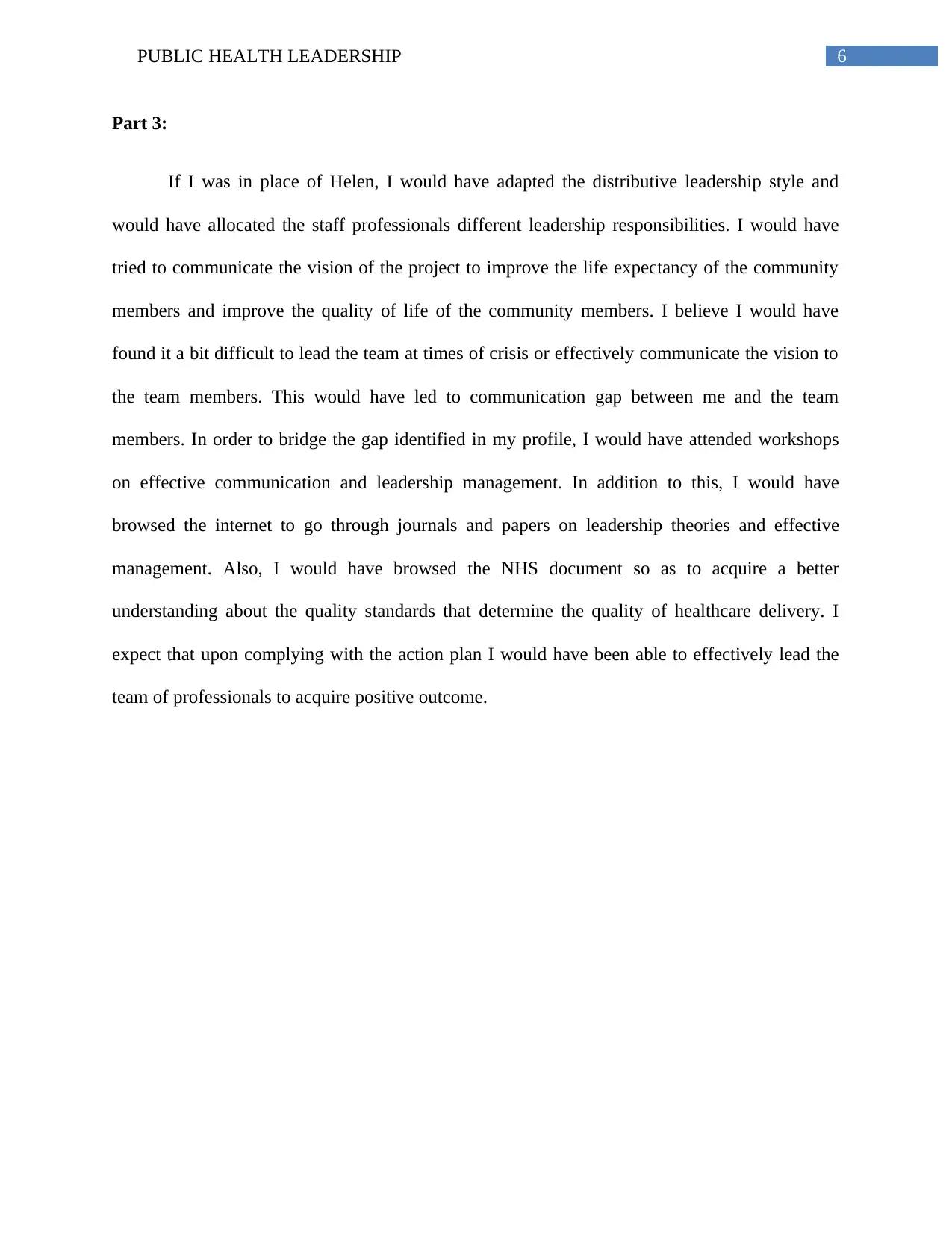
6PUBLIC HEALTH LEADERSHIP
Part 3:
If I was in place of Helen, I would have adapted the distributive leadership style and
would have allocated the staff professionals different leadership responsibilities. I would have
tried to communicate the vision of the project to improve the life expectancy of the community
members and improve the quality of life of the community members. I believe I would have
found it a bit difficult to lead the team at times of crisis or effectively communicate the vision to
the team members. This would have led to communication gap between me and the team
members. In order to bridge the gap identified in my profile, I would have attended workshops
on effective communication and leadership management. In addition to this, I would have
browsed the internet to go through journals and papers on leadership theories and effective
management. Also, I would have browsed the NHS document so as to acquire a better
understanding about the quality standards that determine the quality of healthcare delivery. I
expect that upon complying with the action plan I would have been able to effectively lead the
team of professionals to acquire positive outcome.
Part 3:
If I was in place of Helen, I would have adapted the distributive leadership style and
would have allocated the staff professionals different leadership responsibilities. I would have
tried to communicate the vision of the project to improve the life expectancy of the community
members and improve the quality of life of the community members. I believe I would have
found it a bit difficult to lead the team at times of crisis or effectively communicate the vision to
the team members. This would have led to communication gap between me and the team
members. In order to bridge the gap identified in my profile, I would have attended workshops
on effective communication and leadership management. In addition to this, I would have
browsed the internet to go through journals and papers on leadership theories and effective
management. Also, I would have browsed the NHS document so as to acquire a better
understanding about the quality standards that determine the quality of healthcare delivery. I
expect that upon complying with the action plan I would have been able to effectively lead the
team of professionals to acquire positive outcome.
Paraphrase This Document
Need a fresh take? Get an instant paraphrase of this document with our AI Paraphraser
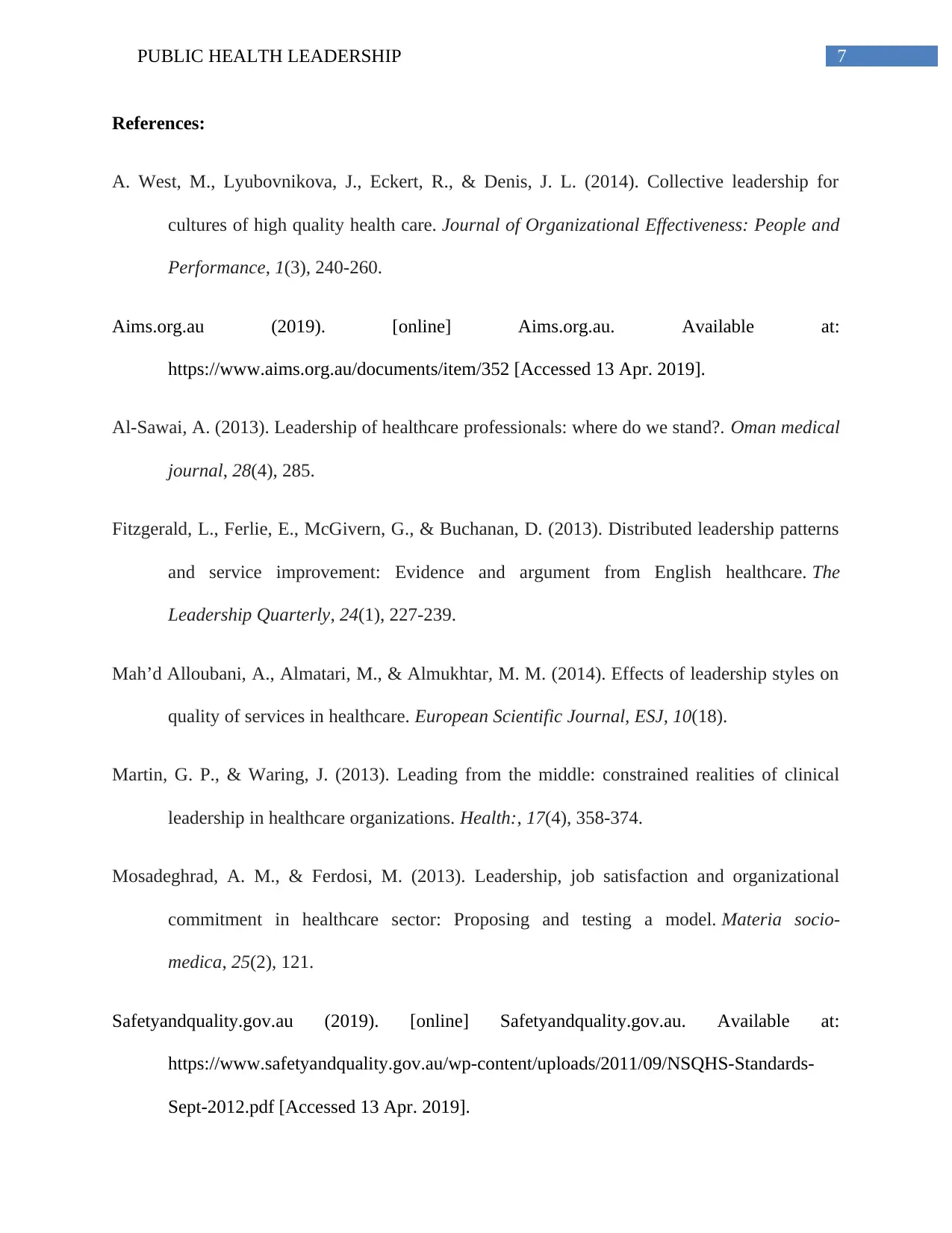
7PUBLIC HEALTH LEADERSHIP
References:
A. West, M., Lyubovnikova, J., Eckert, R., & Denis, J. L. (2014). Collective leadership for
cultures of high quality health care. Journal of Organizational Effectiveness: People and
Performance, 1(3), 240-260.
Aims.org.au (2019). [online] Aims.org.au. Available at:
https://www.aims.org.au/documents/item/352 [Accessed 13 Apr. 2019].
Al-Sawai, A. (2013). Leadership of healthcare professionals: where do we stand?. Oman medical
journal, 28(4), 285.
Fitzgerald, L., Ferlie, E., McGivern, G., & Buchanan, D. (2013). Distributed leadership patterns
and service improvement: Evidence and argument from English healthcare. The
Leadership Quarterly, 24(1), 227-239.
Mah’d Alloubani, A., Almatari, M., & Almukhtar, M. M. (2014). Effects of leadership styles on
quality of services in healthcare. European Scientific Journal, ESJ, 10(18).
Martin, G. P., & Waring, J. (2013). Leading from the middle: constrained realities of clinical
leadership in healthcare organizations. Health:, 17(4), 358-374.
Mosadeghrad, A. M., & Ferdosi, M. (2013). Leadership, job satisfaction and organizational
commitment in healthcare sector: Proposing and testing a model. Materia socio-
medica, 25(2), 121.
Safetyandquality.gov.au (2019). [online] Safetyandquality.gov.au. Available at:
https://www.safetyandquality.gov.au/wp-content/uploads/2011/09/NSQHS-Standards-
Sept-2012.pdf [Accessed 13 Apr. 2019].
References:
A. West, M., Lyubovnikova, J., Eckert, R., & Denis, J. L. (2014). Collective leadership for
cultures of high quality health care. Journal of Organizational Effectiveness: People and
Performance, 1(3), 240-260.
Aims.org.au (2019). [online] Aims.org.au. Available at:
https://www.aims.org.au/documents/item/352 [Accessed 13 Apr. 2019].
Al-Sawai, A. (2013). Leadership of healthcare professionals: where do we stand?. Oman medical
journal, 28(4), 285.
Fitzgerald, L., Ferlie, E., McGivern, G., & Buchanan, D. (2013). Distributed leadership patterns
and service improvement: Evidence and argument from English healthcare. The
Leadership Quarterly, 24(1), 227-239.
Mah’d Alloubani, A., Almatari, M., & Almukhtar, M. M. (2014). Effects of leadership styles on
quality of services in healthcare. European Scientific Journal, ESJ, 10(18).
Martin, G. P., & Waring, J. (2013). Leading from the middle: constrained realities of clinical
leadership in healthcare organizations. Health:, 17(4), 358-374.
Mosadeghrad, A. M., & Ferdosi, M. (2013). Leadership, job satisfaction and organizational
commitment in healthcare sector: Proposing and testing a model. Materia socio-
medica, 25(2), 121.
Safetyandquality.gov.au (2019). [online] Safetyandquality.gov.au. Available at:
https://www.safetyandquality.gov.au/wp-content/uploads/2011/09/NSQHS-Standards-
Sept-2012.pdf [Accessed 13 Apr. 2019].
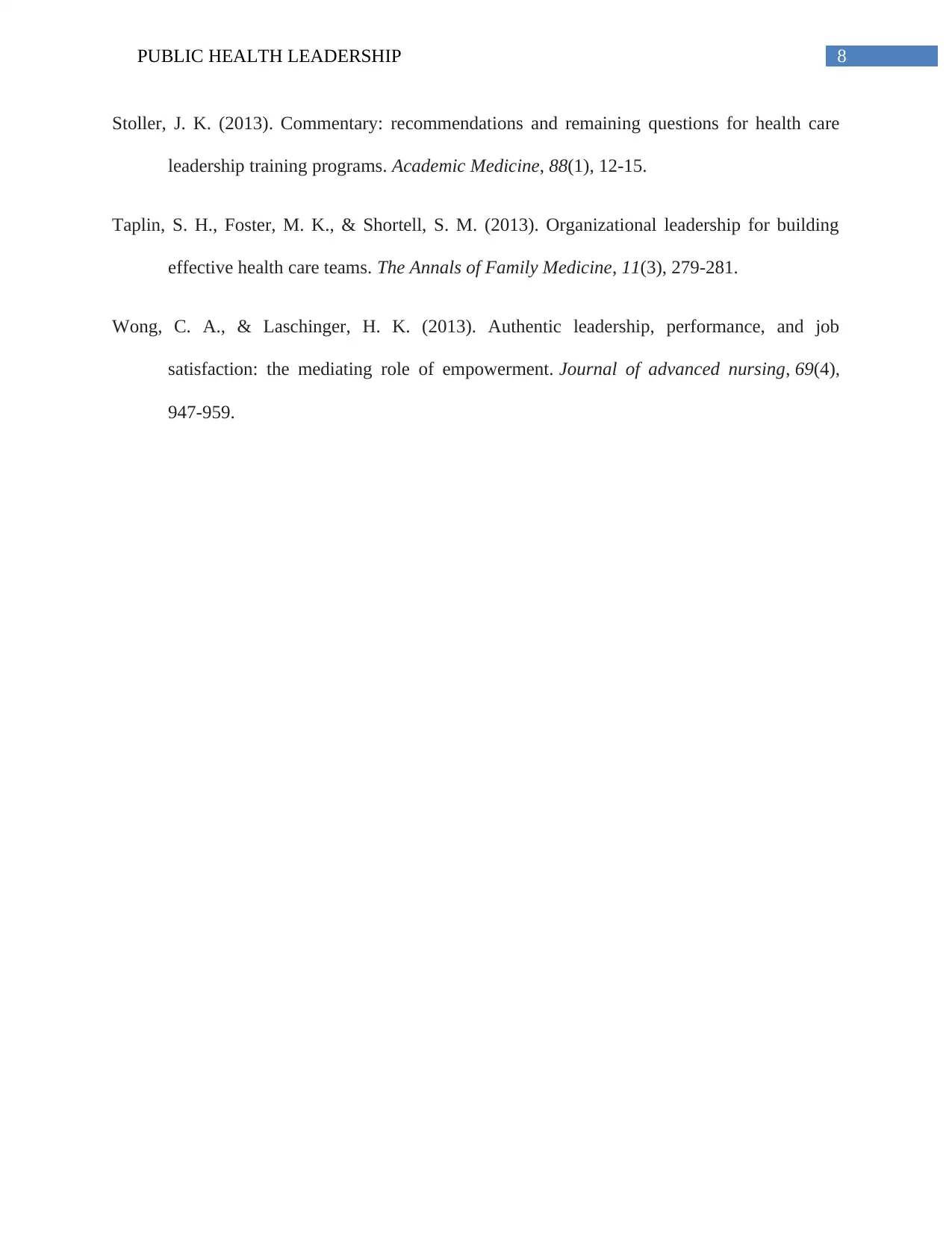
8PUBLIC HEALTH LEADERSHIP
Stoller, J. K. (2013). Commentary: recommendations and remaining questions for health care
leadership training programs. Academic Medicine, 88(1), 12-15.
Taplin, S. H., Foster, M. K., & Shortell, S. M. (2013). Organizational leadership for building
effective health care teams. The Annals of Family Medicine, 11(3), 279-281.
Wong, C. A., & Laschinger, H. K. (2013). Authentic leadership, performance, and job
satisfaction: the mediating role of empowerment. Journal of advanced nursing, 69(4),
947-959.
Stoller, J. K. (2013). Commentary: recommendations and remaining questions for health care
leadership training programs. Academic Medicine, 88(1), 12-15.
Taplin, S. H., Foster, M. K., & Shortell, S. M. (2013). Organizational leadership for building
effective health care teams. The Annals of Family Medicine, 11(3), 279-281.
Wong, C. A., & Laschinger, H. K. (2013). Authentic leadership, performance, and job
satisfaction: the mediating role of empowerment. Journal of advanced nursing, 69(4),
947-959.
⊘ This is a preview!⊘
Do you want full access?
Subscribe today to unlock all pages.

Trusted by 1+ million students worldwide
1 out of 9
Related Documents
Your All-in-One AI-Powered Toolkit for Academic Success.
+13062052269
info@desklib.com
Available 24*7 on WhatsApp / Email
![[object Object]](/_next/static/media/star-bottom.7253800d.svg)
Unlock your academic potential
Copyright © 2020–2025 A2Z Services. All Rights Reserved. Developed and managed by ZUCOL.




